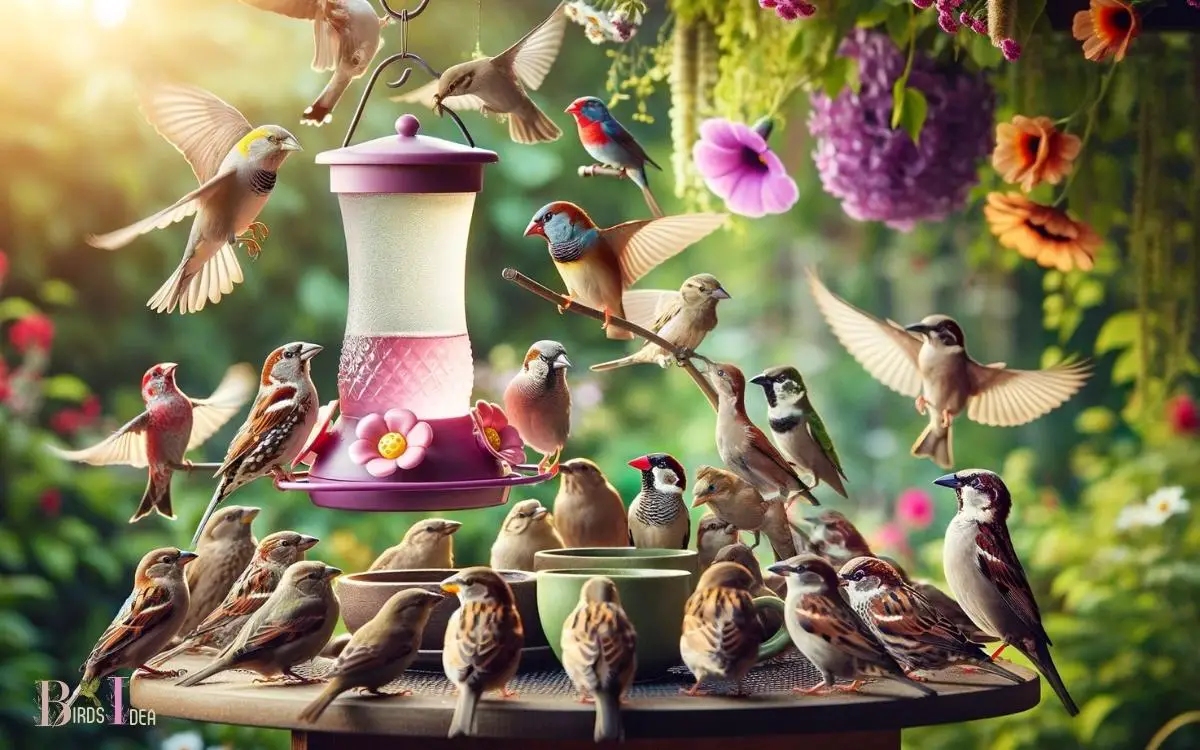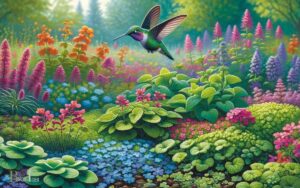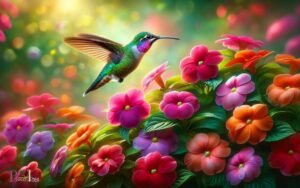Birds Attracted to Hummingbird Feeders: Orioles, Finches!
Hummingbird feeders, designed to dispense nectar, primarily attract hummingbirds. However, several other bird species such as orioles, woodpeckers, finches, and various songbirds might also visit these feeders, enticed by the sweet liquid.
Hummingbird feeders are usually filled with a sugar-water solution that mimics the natural nectar found in flowers.
While they are specifically designed for hummingbirds, with small feeding ports and perches suited to their size, other birds can also be lured by the high-energy food source.
To discourage non-hummingbird visitors, some feeders come equipped with bee guards or are designed in a way that makes it difficult for other birds to feed from them.
While hummingbird feeders are intended for hummingbirds, their sweet contents can invariably attract a diverse array of bird species, making them unexpected but delightful visitors to one’s garden.

Key Takeaway
Factors Influencing Bird Attraction to Hummingbird Feeders
Feeder Design:
The design of hummingbird feeders can have a significant impact on the types of birds attracted.
Different species of hummingbirds may prefer different feeder designs, such as those with perches, multiple feeding ports, or specific shapes. The color and material of the feeder may also play a role in attracting hummingbirds.
Nectar Types:
The type of nectar used in hummingbird feeders can influence bird preferences. Hummingbirds are attracted to nectar that closely resembles the natural nectar of flowers, so the composition and sweetness of the nectar solution can affect which birds are drawn to the feeder.
Experimenting with different nectar formulations may help attract a variety of hummingbird species.
Feeder Placement:
The location of hummingbird feeders is crucial for attracting different bird species. Placing feeders in areas with good visibility and accessibility can attract more birds.
Additionally, considering the height and distance between feeders can impact the hierarchy and interactions between birds.
Some species may prefer feeders in open spaces, while others may be more comfortable near trees or shrubs.
Seasonal Variations:
Bird populations can change based on seasons, affecting the types of birds attracted to hummingbird feeders.
Migration patterns, breeding seasons, and changes in food availability can influence the presence and diversity of hummingbirds.
Adjusting the timing and maintenance of feeders throughout the year can enhance their effectiveness in attracting different species during specific seasons.
Surrounding Habitat:
The surrounding habitat plays a crucial role in bird diversity near feeders. A diverse and natural environment with a variety of plants and flowers can attract a broader range of hummingbirds.
The availability of suitable nesting sites, water sources, and insect populations can also contribute to the overall attractiveness of the area for different bird species.
Considering these factors and making adjustments based on observations can help create an environment that attracts a diverse array of hummingbirds and other bird species to feeders.
Regular monitoring and maintenance of feeders will also contribute to their effectiveness in providing a food source for the avian visitors.
Hummingbirds
Hummingbirds frequently visit hummingbird feeders to sip nectar, attracted by the sweet liquid’s high energy content.
Their rapid metabolism demands that they consume small meals frequently, making feeders a convenient and reliable food source.
These diminutive birds, often weighing less than a nickel, are equipped with long, specialized beaks and extendable, tube-like tongues that allow them to reach deep into flowers and feeders to access nectar.
Their vibrant plumage and aerial acrobatics enhance their allure, captivating the attention of onlookers. Observing their hovering flight and rapid wingbeats is a treat for bird enthusiasts.
Understanding the behaviors and preferences of these fascinating creatures can lead to a deeper appreciation of their ecological role and the importance of providing suitable habitats for their survival.
Orioles
Orioles are known for their bright colors and melodious songs, making them a delight to observe in any backyard.
These birds are also attracted to the same nectar that hummingbirds enjoy, making hummingbird feeders an effective way to attract orioles.
By providing the right type of feeder and nectar, bird enthusiasts can increase the likelihood of seeing orioles frequenting their yards.
Orioles and Hummingbird Feeders
An estimated 25% of orioles are known to be attracted to hummingbird feeders during the spring and summer months.
Orioles are primarily nectar feeders and are drawn to the sweet liquid found in hummingbird feeders.
Their vibrant plumage and sweet, melodious songs make them a delight to observe in the garden.
When orioles visit hummingbird feeders, they often cling to the feeding ports and use their specialized brush-tipped tongues to consume the nectar.
Unlike hummingbirds, orioles may also feed on ripe fruits and insects, adding variety to their diet.
Their presence at feeders adds a splash of color and activity to any outdoor space, providing bird enthusiasts with a unique opportunity for close observation.
This behavior also presents an opportunity to explore methods of attracting orioles with feeders.
Attracting Orioles With Feeders
Attracting Orioles with feeders requires strategic placement and offering a diverse array of nectar, fruits, and insects.
Orioles are attracted to bright colors, so using orange slices or offering nectar in an orange-colored feeder can be particularly effective.
Placing the feeders near the edges of wooded areas or near water sources, where orioles typically forage, can also increase the likelihood of attracting them.
Orioles are known to enjoy a variety of fruits, such as grapes, apple slices, and bananas. Additionally, providing protein-rich food like mealworms or suet can further entice them to visit the feeders.
By creating an environment that mimics their natural foraging habits, bird enthusiasts can successfully attract orioles to their feeders.
Woodpeckers
Woodpeckers are known to be attracted to hummingbird feeders, where they can often be seen feeding on the sweet nectar.
Observing woodpecker behavior around feeders can provide valuable insights into their feeding habits and interactions with other bird species.
Designing woodpecker-friendly feeders can help ensure that these beautiful birds have access to the food they need while minimizing competition from other feeder visitors.
Woodpeckers and Feeders
Woodpeckers’ attraction to feeders is influenced by the availability of suet and nuts. Suet provides woodpeckers with high-energy fat that is essential for their survival, especially during colder months.
The nuts offer a good source of protein and fats. Feeders with suet cages and platforms for nuts tend to attract woodpeckers more effectively.
Woodpeckers are known for their clinging and perching habits, so feeders with sturdy perches and good footholds are preferred.
Additionally, the position of the feeder is crucial; woodpeckers are more likely to visit feeders placed near trees or in semi-sheltered areas, as they feel more secure and can quickly escape to nearby vegetation if needed.
Understanding these preferences can help bird enthusiasts attract and observe woodpeckers at their feeders.
Woodpecker Behavior Around Feeders
Frequently, woodpeckers exhibit distinct behaviors around feeders that can be influenced by the availability of suet and nuts.
Woodpeckers are known to be attracted to suet feeders due to their high-fat content, which provides essential energy, especially during colder months.
These birds often show a characteristic clinging behavior while feeding, using their stiff tail feathers for support against the feeder’s surface.
Additionally, woodpeckers may display territorial behavior around feeders, chasing away other birds that approach the feeding area.
Their strong beaks and specialized tongues allow them to extract insects, nuts, and seeds from feeders, often creating distinctive drumming sounds while foraging.
Observing these behaviors can provide valuable insights into the foraging and social dynamics of woodpecker populations, contributing to our understanding of their ecological roles.
Woodpecker-Friendly Feeder Designs
Attracting woodpeckers to feeders can be achieved by incorporating designs that cater to their feeding behavior and dietary preferences, such as providing suet and nuts.
Woodpeckers are attracted to suet feeders, especially during colder months when insects are scarce.
Opt for suet feeders with large cages or tail props, allowing woodpeckers to cling and feed comfortably.
Additionally, offering nuts in wire mesh feeders or platforms can attract woodpeckers, as they are known to feed on insects, fruits, and nuts.
Consider using feeders with extended tail supports to accommodate the woodpecker’s unique feeding posture.
Providing a mix of suet and nuts in different feeder designs can attract a variety of woodpecker species to your backyard.
Warblers
Warblers are commonly seen around and near hummingbird feeders during the spring and fall migrations.
These small, energetic birds are often attracted to the sugary water found in hummingbird feeders.
Some key observations about warblers and their interaction with hummingbird feeders include:
- Warblers are known for their insect-eating habits, but during migration, they also seek out nectar sources for energy.
- Their colorful plumage and quick, darting movements make them a delight to watch as they flit around the feeders.
- Warblers are more likely to visit feeders with a variety of perching options, such as small branches or thin rods, as they prefer to cling while feeding.
- Providing fresh nectar and maintaining a clean feeding area can attract warblers and ensure their return visits.
- It is important to position feeders where warblers can find shelter nearby, such as in shrubs or trees, as they are often cautious and prefer cover while feeding.
Finches
Finches are often drawn to hummingbird feeders due to their attraction to the seeds and grains found in the surrounding area.
Their preference for small seeds makes them frequent visitors to feeders containing nyjer, millet, or sunflower seeds.
Observationally, finches, like the American goldfinch, house finch, and purple finch, exhibit acrobatic feats while perched on the slender ports of hummingbird feeders, using their agile feet to cling on.
Their distinctive calls and vibrant plumage make them a delightful addition to any feeder. The availability of seeds and the presence of other finches often attract them to these feeding stations.
Understanding the feeding habits of finches can enhance the birdwatching experience for enthusiasts.
Sparrows
Some sparrows are often drawn to hummingbird feeders due to their attraction to the seeds and grains found in the surrounding area. Sparrows are known for their diverse diet, which includes seeds, grains, and small insects.
When these resources are available near hummingbird feeders, sparrows are likely to visit the area.
The proximity of cover and perches, such as bushes and trees, also makes the area around hummingbird feeders attractive to sparrows.
Additionally, the communal nature of sparrows means that where one sparrow finds food, others are likely to follow.
The availability of water sources near hummingbird feeders further increases the attractiveness of these locations to sparrows, as they require water for drinking and bathing.
- Diverse diet including seeds, grains, and small insects
- Proximity of cover and perches
- Communal nature
- Availability of water sources
Thrushes
Thrushes are attracted to hummingbird feeders due to the availability of fruits and insects in the nearby vegetation and the presence of perches for resting and observing their surroundings.
Thrushes, such as the American Robin and Hermit Thrush, are primarily fruit-eating birds but also forage for insects.
They are attracted to the sugary nectar found in hummingbird feeders as a readily available energy source.
The feeders also provide a convenient place for thrushes to perch and keep an eye out for potential predators while they feed.
Additionally, the presence of thrushes at hummingbird feeders can add a delightful diversity to the avian visitors in a backyard, enriching the overall birdwatching experience for enthusiasts.
Observing thrushes at hummingbird feeders provides a valuable opportunity to study their behavior and interaction with other bird species.
Tanagers
Tanagers are also attracted to hummingbird feeders, drawn by the sweet nectar and the opportunity to perch and observe their surroundings.
These small, colorful birds are often seen visiting feeders in search of food and a place to rest.
Observations have shown that tanagers exhibit certain behaviors when visiting hummingbird feeders:
- Tanagers prefer feeders with perches, allowing them to rest between feeding.
- They are known to be cautious feeders, often observing the surroundings before approaching the feeder.
- Tanagers may display territorial behavior around the feeder, especially during the breeding season.
- They have been observed to visit feeders more frequently during the morning and late afternoon.
- Tanagers are attracted to feeders with fresh, clear nectar, and may avoid feeders with spoiled or discolored nectar.
Tips for Optimizing Bird Diversity with Hummingbird Feeders
Optimizing bird diversity with hummingbird feeders involves creating an environment that caters to a variety of bird species.
Varied Feeder Types:
- Hummingbird Feeders: Opt for feeders with different designs and sizes to attract various hummingbird species. Some may prefer larger feeders, while others might be more attracted to smaller ones.
- Seed Feeders: Include tube feeders, hopper feeders, and platform feeders to accommodate seed-eating birds like finches, sparrows, and cardinals. Vary the seed types to attract different species.
- Suet Feeders: Suet is especially attractive to woodpeckers, nuthatches, and chickadees. Use different suet feeder styles such as cages or logs to appeal to a diverse range of birds.
Diverse Food Offerings:
- Nectar for Hummingbirds: Provide a mixture of nectar with varying concentrations to cater to different hummingbird species. Experiment with different nectar recipes, and avoid using red dye.
- Seed Variety: Offer a mix of seeds like sunflower seeds, millet, and nyjer seeds to attract a broader spectrum of seed-eating birds.
- Suet Blends: Try different suet blends, including those with nuts, berries, or insects, to attract a variety of insect-eating birds.
Maintenance Practices:
- Cleanliness: Regularly clean and disinfect feeders to prevent the spread of diseases. Hummingbird feeders, in particular, should be cleaned every few days to avoid mold and bacteria.
- Fresh Food: Ensure that the food provided is fresh, as stale or spoiled food can deter birds from visiting. Replace seeds and suet as needed to maintain quality.
- Feeder Placement: Position feeders in locations that are easily accessible to birds but also provide some protection from predators. Consider placing feeders at different heights to accommodate various bird species.
Landscaping for Birds:
- Native Plants: Plant native flowers, shrubs, and trees that produce fruits, seeds, and nectar, providing natural food sources for birds.
- Water Sources: Include birdbaths or shallow water dishes nearby, as birds need water for drinking and bathing. This can attract a broader range of species.
- Shelter: Provide trees and bushes for birds to perch on and find shelter. This makes the area around the feeders more attractive and encourages diverse bird species to visit.
By incorporating these tips, you can create a welcoming environment for a wide range of bird species, enhancing the diversity around your hummingbird feeders.
Conclusion
It is fascinating to observe the variety of bird species that are attracted to hummingbird feeders. From the vibrant hummingbirds to the striking orioles and woodpeckers, the feeder serves as a hub for avian activity.
The diversity of species raises the question: what other insights can be gained from studying their interactions at the feeder? It is a captivating subject for further scientific observation and study.






